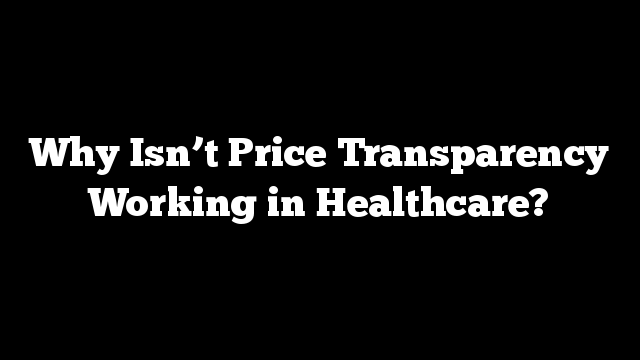
By TAYLOR CHRISTENSEN, MD
I strongly believe that getting people the information and incentives necessary to choose higher-value providers and insurers is the solution to improving value in healthcare (see my Healthcare Incentives Framework). But, you say, we’ve tried that and it doesn’t work, and current efforts are a waste of time!
Here’s an example of some great research that you might use to support your opinion:
Examining a Health Care Price Transparency Tool: Who Uses It, and How They Shop for Care (Sinaiko and Rosenthal, Health Affairs, April 2016)
The news media would see this and report the main findings–that only 3% of enrollees used Aetna’s price comparison tool–and argue that even people who have the opportunity to shop for care will not do it, which they will interpret to mean any “consumer-driven” healthcare effort is proven through evidence not to work. People can wrest information to prove whatever they want.
But what if you actually read the study?
Sinaiko and Rosenthal found that only about 60% of enrollees even had a claim during their study period. And of those 60%, I’m guessing a large percentage of those were outpatient visits (primary care or specialty) with established providers, which are claim types that people historically do not shop for. Think about it, if you have your favorite hairdresser who knows you best, you have a relationship with that person, and you like how they cut your hair, are you going to price shop every single time you need to get your hair cut?
Now take out all the non-shoppable services (something we should look at further sometime), and we’re left with a relatively small percentage of enrollees who may have actually had a reason to shop for care. But, wait, what about the people whose insurance plan required them to pay the same amount regardless of which provider they chose? (Remember, people need an incentive to choose higher-value options.) That’s a lot of exclusions, and I wish I had the numbers to know what percent of enrollees would be left. 30%? 10%? Those are the enrollees who would be the target audience for this price comparison tool.
I assume Aetna did a good job notifying people about this price comparison tool, so maybe 75% of people read the mailer and then half of them remembered it when it came time to shop for care. Why only half? Because people aren’t yet accustomed to shopping around for value in healthcare. They’re used to going to the lab or imaging center or specialist their doctor tells them to go to. It doesn’t even cross their mind that there may be cheaper options out there. There’s also an assumption that you have to go where your doctor tells you otherwise your doctor can’t get the results. It’s not true, but it can be very inconvenient to get records from somewhere. Thanks, non-interoperable EMRs.
So what are we left with? 3% of enrollees seems about right.
But what if we look specifically at services that are known to be shoppable? Considering all the factors above, the percent of people who shopped before getting those services blew me away. Tonsillectomy: 54%. Total knee replacement: 48%. Inguinal hernia repair: 27%. Cararact or lens procedure: 18%. Vaginal delivery or C section: 16%. Carpal tunnel release: 12%. These lower-percentage ones strike me as the ones that would more commonly be performed by a doctor you’re already established with (again, making you less likely to shop around), but I could be wrong here.
Anyway, you know what this proves to me? That price comparison tools can work! And I believe they will be used more and more as people start getting insurance plans that require them to pay more for more expensive options, and as they remember they can shop for price. The younger generation will probably drive a lot of this because they will be more used to using these tools and shopping for care and will eventually get older and start needing more services.
Here’s another great paper that sheds more light on this topic:
Americans Support Price Shopping for Health Care, But Few Actually Seek Out Price Information (Mehrotra, Dean, Sinaiko, and Sood, Health Affairs, August 2017)
Check out these numbers, looking specifically at people who have the type of insurance plans that would give them an incentive to compare prices:
- 72% of people think it’s really important to shop for value in healthcare
- 93% of people know prices vary greatly among providers
- Only 22% of people think higher prices in healthcare equate to better quality
- 75% of people said they don’t know of a resource they can use to compare costs among providers
- 77% of people who didn’t price shop for their last healthcare service said it was because they were seeing a provider with whom they were already established
- Only 1% said they didn’t shop because it was emergency care
I’m impressed that so many people know about the unwarranted price variations and think shopping in healthcare is important, but it’s sad that only 25% of people even know of a resource they could use to compare costs. And, like I said above, we see that most people aren’t doctor shopping when they’ve already established with a provider.
So, instead of making the jump from “price transparency doesn’t work right now” to “price transparency will never work,” let’s take a more constructive approach and actually understand what’s interfering with people shopping for care so we can fix it. Because even Medicare for All will not be a solution to our healthcare spending problem without getting people to shop for their care.
Taylor J. Christensen is an internal medicine physician and health policy researcher who blogs about how to fix the healthcare system at clearthinkingonhealthcare.com.
The post Why Isn’t Price Transparency Working in Healthcare? appeared first on The Health Care Blog.
